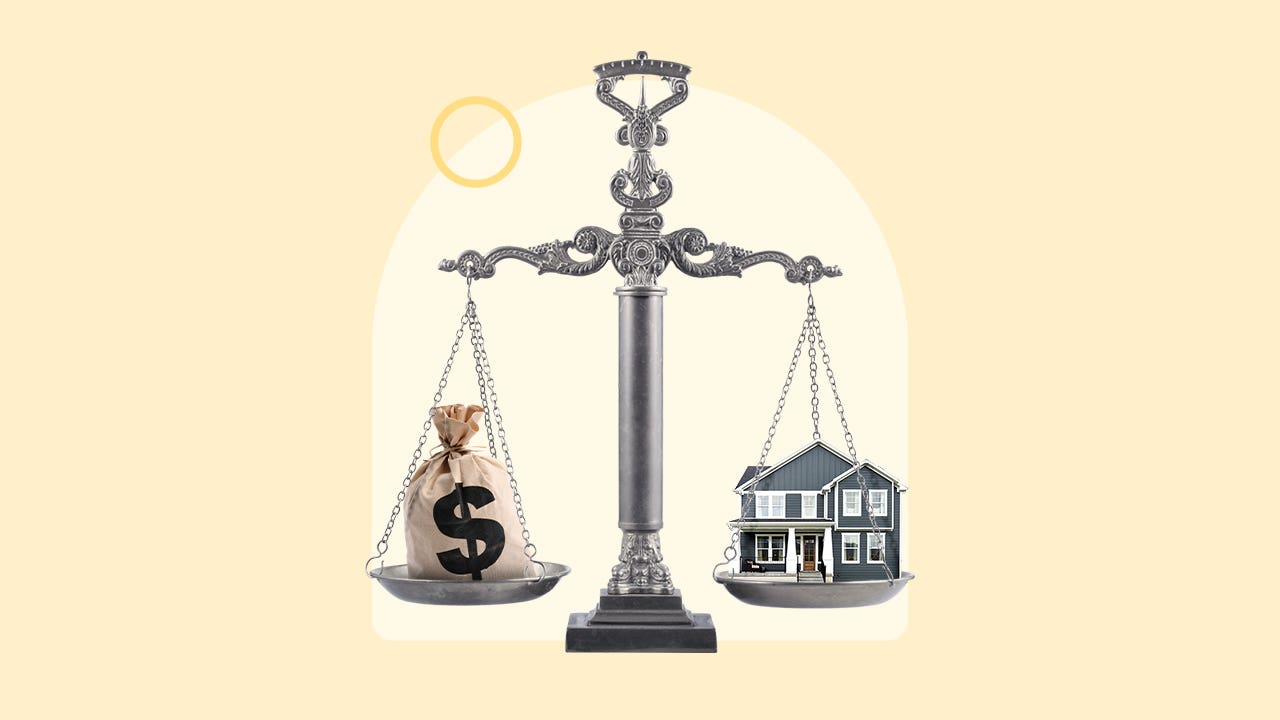What is a loan-to-value ratio?

Key takeaways
- Your loan-to-value (LTV) ratio is the balance of your mortgage loan divided by the value of the property you’re buying, usually expressed as a percentage.
- A lower LTV ratio can help you get a lower interest rate on your mortgage.
- Lenders set a maximum LTV ratio for the home loans they issue.
What is a loan-to-value (LTV) ratio?
In a real estate context, your loan-to-value ratio is the amount of money you’re borrowing, also called the loan principal, divided by the value of the property you want to buy. An LTV ratio is usually expressed as a percentage.
When you apply for a mortgage, your lender will factor in your LTV ratio when deciding whether to approve you for the loan and when determining your loan size and interest rate.
LTV also comes into play when you apply to refinance a mortgage. Your remaining loan balance divided by your home value is one major criteria lenders use when approving or denying your refinance application.
How to calculate a loan-to-value ratio
To calculate your LTV ratio, you’ll first need to subtract your down payment from your home’s appraised value. Then, divide that figure by the appraised value and multiply it by 100. Here’s how that formula would look:
(Home’s appraised value – down payment) ÷ Appraised value x 100 = LTV ratio
Let’s say that you plan to borrow $450,000 to buy a $500,000 house. Your LTV ratio — $450,000 divided by $500,000, multiplied by 100 — would be 90 percent.
Why lenders look at LTV during the mortgage process
Before a bank or lender approves your mortgage application, the lender’s underwriting department needs to be confident you can pay the loan back.
Loan-to-value ratio is one piece of the puzzle. Lenders prefer borrowers to have a lower LTV ratio and more equity in the house from the outset. This lowers your likelihood of ending up underwater on your mortgage and defaulting on the loan.
Lenders also look at your debt-to-income (DTI) ratio to evaluate your overall financial picture. After reviewing your LTV and DTI ratios, the lender may decide to approve your loan or not. If your ratios aren’t ideal, a lender may still approve your loan, but you’ll likely pay a higher interest rate, which translates to paying more money over the life of the loan.
What is a good loan-to-value ratio?
The ideal LTV ratio depends on the lender’s requirements and the loan type. For you as the borrower, however, a “good” LTV ratio means you’re putting more money down and borrowing less. In general, the lower your LTV ratio, the better.
Loan-to-value ratio requirements by loan type
There are many types of mortgages, and their specific loan-to-value ratio requirements vary. Some mortgages allow a far higher loan-to-value ratio than others.
| Loan type | LTV maximum |
|---|---|
| *Without private mortgage insurance (PMI) | |
| Conventional loan* | 80% |
| FHA loan | 96.5% |
| VA loan | 100% |
| USDA loan | 100% |
| Refinance* | 80% |
- Conventional loan: You can get a conventional loan for 3 percent down, but if you can make a 20 percent down payment, you won’t have to pay private mortgage insurance.
- FHA loan: You can typically qualify for an FHA loan with an LTV ratio of 96.5 percent. Keep in mind that you’re required to pay mortgage insurance on FHA loans no matter the size of your down payment.
- VA loan: If you’re a service member, veteran or surviving spouse, you can have a 100 percent LTV ratio with a VA loan — that is, make no down payment — provided you meet other requirements for approval.
- USDA loan: Available to low- and moderate-income homebuyers in rural areas, the U.S. Department of Agriculture approves eligible borrowers with a 100 percent LTV ratio as well.
- Refinancing: If you’re considering refinancing your mortgage, most lenders will want to see an LTV ratio of 80 percent or lower, in other words, at least 20 percent equity.
What is combined LTV (CLTV)?
If you already have a home loan and want to apply for a second mortgage, your lender will evaluate your combined LTV (CLTV) ratio. This factors in all of the loan balances on the property: the outstanding balance on the first mortgage, and now the second mortgage.
Let’s say you have an outstanding balance of $250,000 on a home that is appraised at $500,000, and you want to borrow $30,000 in a home equity line of credit (HELOC) to pay for a kitchen renovation. Here’s a breakdown of the combined LTV ratio:
($250,000 + $30,000) / $500,000 = 56 percent CLTV
If you have a HELOC and want to apply for another loan, your lender might look at a similar formula called the home equity combined LTV (HCLTV) ratio. This figure represents the total amount of the HELOC against the value of your home, not just what you’ve drawn from the line of credit.
LTV vs. CLTV
LTV and CLTV both describe how much equity you have in your home versus how much you owe on it. The difference is the LTV only accounts for your primary mortgage, while the CLTV factors in your first mortgage and any subsequent home-related debt, such as a HELOC or home equity loan.
You can use Bankrate’s loan-to-value ratio calculator to determine your CLTV ratio and compare it to your LTV ratio.
How to lower your LTV
When rates are relatively high, there’s only so much you can do to lower your interest rate — which will save you money on your monthly payment and on your mortgage long-term — but lowering your LTV is one option. You can do this in one of two ways:
- You can save more money to make a larger down payment.
- You can find a cheaper property.
If you can manage to put down 20 percent on a conventional loan, you’ll not only likely receive a lower interest rate than if you’d made a smaller down payment, but you won’t have to pay for PMI, which is a cost added to your monthly mortgage payment.
You can determine how much house you can afford using Bankrate’s home calculator.
You may also like

What is a high interest rate for a car loan?

How to calculate interest on a loan

What is mortgage loan origination?

Questions to ask a mortgage lender



